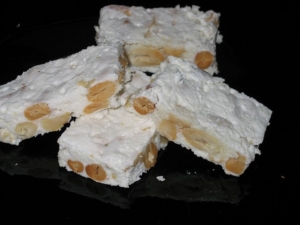Traditional Spanish Turrón
Turrón is perhaps the most well known of Spanish sweets and although it can be enjoyed any time of year, it is particularly famous for its traditional appearance at Christmas time. Spanish children are excited when the first turrón of the season is brought home as it is a signal that the Christmas season is fast approaching.
The origin of this famous Spanish food is said to go back over five hundred years to when the first example of this gorgeous sweet was first created by the Moors in the small town of Jijona, north of Alicante. Jijona and turrón still go hand in hand today, the town is famous for its production and it is home to the Turrón Museum where the most famous and expensive brand of turrón, 1880 can be found. Jijona and Alicante turrón are the most well known types of turrón, named after the location where they were created.
Turrón de Alicante is a hard, nougat type, so full of almonds that it would crumble if any more were squeezed in. Turrón de Jijona, sometimes called the original turrón is soft and sticky, a little like fudge.
The most important ingredients of turrón are honey and almonds and only the finest local examples of both, which are found in abundance in the regions of Alicante and Catalonia, go into the very best turrón.
Apart from the Alicante and Jijona turrón, whose recipes have remained unchanged for generations, there are many variations and types and turrón is today made all over Spain. A fairly new but extremely popular type of turrón is the yema tostada where ground almonds and egg yolks are mixed together and toasted for a soft and sweet treat. There is also the turrón de chocolate which comes in various types ranging from extrafino to popular depending on the percentage of cocoa utilized in its production.
Whatever the type of this Spanish food you prefer, the quality is an important factor. The best turrón available is the supreme quality. Producers must abide by strict rules in order to be allowed to label their turrón as supremo, there must be at least 64% of almonds present in the hard Alicante turrón and 60% contained in the soft Jijona turrón.
The finest way to enjoy turrón is to serve up a selection of samples of each after dinner with a coffee and liqueur. As a treat for the children, crumble a generous amount over soft vanilla ice cream. The Spanish also love having little tasters of the different types of turrón with a glass of cava for a very festive aperitif. It truly is one of Spain’s sweet delights and is enjoyed by all whatever the occasion or time of year.
If you would like to try turrón and other such Spanish specialties here in Spain, our Taste Your Way Through Catalonia Tour includes visits to authentic Spanish producers such to the oldest flour mill in Europe, an Apiary in the hills of Osona, a Goats Cheese producer and a Jam & Marmalade Museum.



